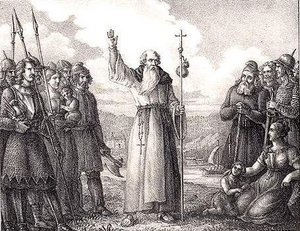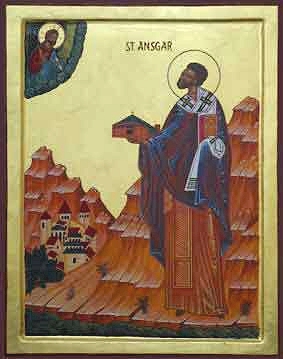Born near
Amiens, Picardy, France in 801, died in Bremen, Germany on
February 3, 865.
With the
coming of the barbarians after the death of Charlemagne,
darkness fell upon Europe. From the forests and the fjords
of the north, defying storm and danger, came a horde of
pirate invaders, prowling round the undefended coasts,
sweeping up the broad estuaries, and spreading havoc and
fear. No town, however fair, no church, however sacred, and
no community, however strong, was immune from their fury.
Like a river of death the Vikings poured across Europe.
It's hard
to believe that there would be an outbreak of missionary
activity at such a time, but in Europe's darkest hour there
were those who never faltered, and who set out to convert
the pagan invader. St.Ansgar was such a man. As a young boy
of a noble family he was received at Corbie monastery in
Picardy and educated under Saint Abelard and Paschasius
Radbert. Once professed, he was transferred to New Corbie at
Westphalia. He once said to a friend, " One miracle I would,
if worthy, ask the Lord to grant me, and that is, that by
his grace, he would make me a good man."
In France
a call was made for a priest to go as a missionary to the
Danes, and Ansgar, a young monk, volunteered. His friends
tried to dissuade him, so dangerous was the mission.
Nevertheless, when King Harold, who had become a Christian
during his exile, returned to Denmark, Ansgar and another
monk accompanied him. Equipped with tents and books, these
two monks set out in 826 and founded a school in Denmark.
Here Ansgar's companion died, and Ansgar was obliged to move
on to Sweden alone when his success in missionary work led
King Bjørn to invite him to Sweden.
On the way
his boat was attacked by pirates and he lost all his
possessions, arriving destitute at a small Swedish village.
After this unpromising start, he succeeded forming the
nucleus of a church -- the first Christian church in Sweden
-- and penetrated inland, confronting the heathen in their
strongholds and converting the pagan chiefs.
Ansgar
became the first archbishop of Hamburg, Germany and abbot of
New Corbie in Westphalia c. 831. The Pope Gregory IV
appointed him legate to the Scandinavian countries and
confides the Scandinavian souls to his care. He evangelized
there for the next 14 years, building churches in Norway,
Denmark and northern Germany.
He saw his
accomplishments obliterated when pagan Vikings invaded in
845, overran Scandinavia, and destroyed Hamburg. Thereafter
the natives reverted to paganism. Ansgar was then appointed
archbishop of Bremen around 848, but he was unable to
establish himself there for a time and Pope Nicholas 1
united that See with Hamburg. Nicholas also gave him
jurisdiction over Denmark, Norway, and Sweden.
Ansgar
returned to Denmark and Sweden in 854 to resume spreading
the Gospel. When he returned to Denmark he saw the church
and school he had built there, destroyed before his eyes by
an invading army.
His heart
almost broke as he saw his work reduced to ashes" The Lord
gave," he said, "and the Lord have taken away. Blessed be
the name of the Lord." With a handful of followers he
wandered through his ruined diocese, but it was a grim and
weary time. "Be assured my dear brother, " said the primate
of France, who had commissioned him to this task, "that what
we have striven to accomplish for the glory of Christ will
yet, by God's help, bring forth fruit."
Heartened
by these words, and with unfailing courage, Ansgar pursued
his Swedish mission. Though he had but four churches left
and could find no one willing to go in his place, he
established new outposts and consolidated his work.
King Olaf
had cast a die to decide whether to allow entrance of
Christians, an action that Ansgar mourned as callous and
unbefitting. He was encouraged, however, by a council of
chiefs at which an aged man spoke in his defense. "Those who
bring to us this new faith," he said" by their voyage here
have been exposed to many dangers. We see our own deities
failing us. Why reject a religion thus brought to our very
doors? Why not permit the servants of God to remain among
us? Listen to my council and reject not what is plainly for
our advantage."
As a
result, Ansgar was free to preach the Christian faith, and
though he met with many setbacks, he continued his work
until he died at the age of 64 and was buried at Bremen. He
was a great missionary, an indefatigable, outstanding
preacher, renowned for his austerity, holiness of life, and
charity to the poor. He built schools and was a great
liberator of slaves captured by the Vikings. He converted
King Erik of Jutland and was called the "Apostle of the
North", yet Sweden reverted completely to paganism shortly
after Ansgar's death.
Ansgar
often wore a hair shirt, lived on bread and water when his
health permitted it, and added short personal prayers to
each Psalm in his Psalter, thus contributing to a form of
devotion that soon became widespread.
Miracles
were said to have been worked by him. After Ansgar's death,
the work he had begun came to a stop and the area reverted
to paganism. Christianity did not begin to make headway in
Scandinavia until two centuries later with the work of Saint
Sigfried and others. A life story was written about Ansgar
by his fellow missionary in Scandinavia, Saint Rembert (Attwater,
Attwater2, Benedictines, Bentley, Coulson, Delaney,
Encyclopedia, Fanner, Gill, Robinson, White)
In art
Ansgar is shown with converted Danes with him (White),
wearing a fur pelisse (Roeder). He may sometimes be shown
otherwise in a boat with King Harold and companions or in a
cape and miter Hamburg Cathedral (Roeder).

Saint
Ansgar is the patron of Denmark, Germany and Iceland
(White). He is venerated in Old Corbie (Picardy) and New
Corbie (Saxony) as well as in Scandinavia (Roeder).

